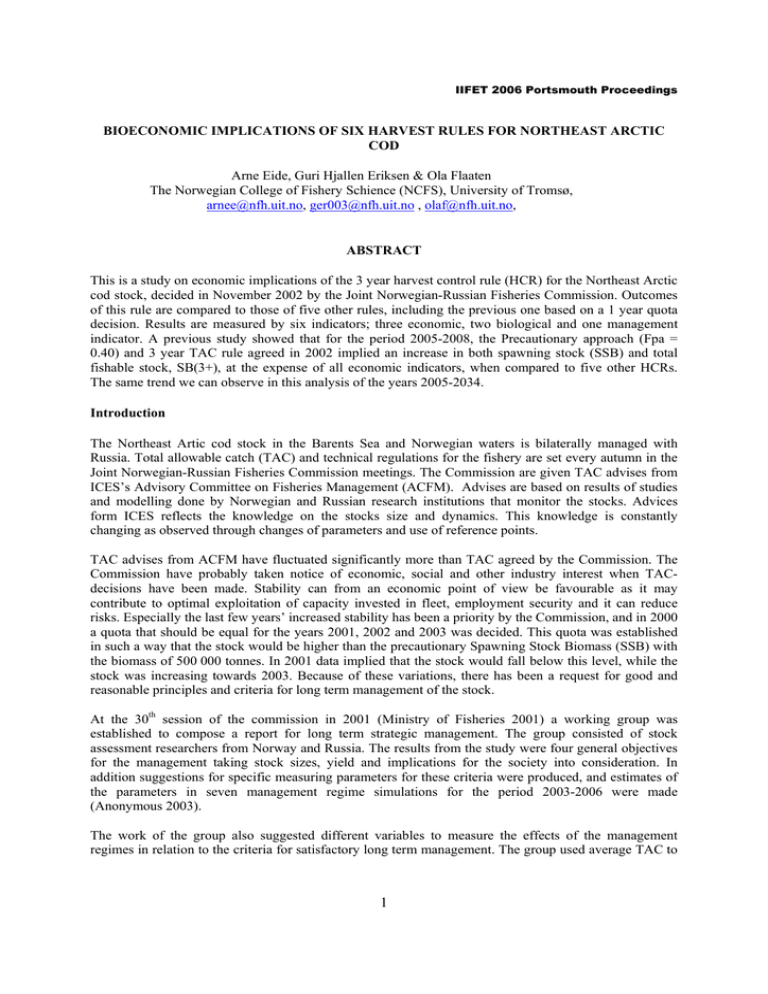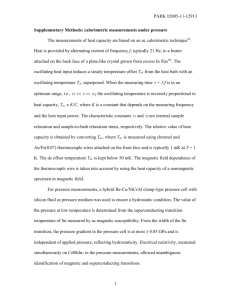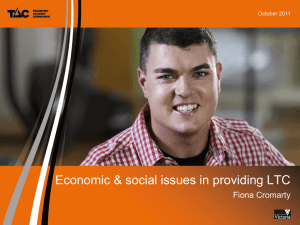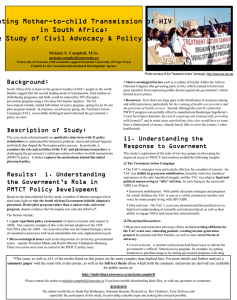BIOECONOMIC IMPLICATIONS OF SIX HARVEST RULES FOR NORTHEAST ARCTIC COD
advertisement

IIFET 2006 Portsmouth Proceedings BIOECONOMIC IMPLICATIONS OF SIX HARVEST RULES FOR NORTHEAST ARCTIC COD Arne Eide, Guri Hjallen Eriksen & Ola Flaaten The Norwegian College of Fishery Schience (NCFS), University of Tromsø, arnee@nfh.uit.no, ger003@nfh.uit.no , olaf@nfh.uit.no, ABSTRACT This is a study on economic implications of the 3 year harvest control rule (HCR) for the Northeast Arctic cod stock, decided in November 2002 by the Joint Norwegian-Russian Fisheries Commission. Outcomes of this rule are compared to those of five other rules, including the previous one based on a 1 year quota decision. Results are measured by six indicators; three economic, two biological and one management indicator. A previous study showed that for the period 2005-2008, the Precautionary approach (Fpa = 0.40) and 3 year TAC rule agreed in 2002 implied an increase in both spawning stock (SSB) and total fishable stock, SB(3+), at the expense of all economic indicators, when compared to five other HCRs. The same trend we can observe in this analysis of the years 2005-2034. Introduction The Northeast Artic cod stock in the Barents Sea and Norwegian waters is bilaterally managed with Russia. Total allowable catch (TAC) and technical regulations for the fishery are set every autumn in the Joint Norwegian-Russian Fisheries Commission meetings. The Commission are given TAC advises from ICES’s Advisory Committee on Fisheries Management (ACFM). Advises are based on results of studies and modelling done by Norwegian and Russian research institutions that monitor the stocks. Advices form ICES reflects the knowledge on the stocks size and dynamics. This knowledge is constantly changing as observed through changes of parameters and use of reference points. TAC advises from ACFM have fluctuated significantly more than TAC agreed by the Commission. The Commission have probably taken notice of economic, social and other industry interest when TACdecisions have been made. Stability can from an economic point of view be favourable as it may contribute to optimal exploitation of capacity invested in fleet, employment security and it can reduce risks. Especially the last few years’ increased stability has been a priority by the Commission, and in 2000 a quota that should be equal for the years 2001, 2002 and 2003 was decided. This quota was established in such a way that the stock would be higher than the precautionary Spawning Stock Biomass (SSB) with the biomass of 500 000 tonnes. In 2001 data implied that the stock would fall below this level, while the stock was increasing towards 2003. Because of these variations, there has been a request for good and reasonable principles and criteria for long term management of the stock. At the 30th session of the commission in 2001 (Ministry of Fisheries 2001) a working group was established to compose a report for long term strategic management. The group consisted of stock assessment researchers from Norway and Russia. The results from the study were four general objectives for the management taking stock sizes, yield and implications for the society into consideration. In addition suggestions for specific measuring parameters for these criteria were produced, and estimates of the parameters in seven management regime simulations for the period 2003-2006 were made (Anonymous 2003). The work of the group also suggested different variables to measure the effects of the management regimes in relation to the criteria for satisfactory long term management. The group used average TAC to 1 IIFET 2006 Portsmouth Proceedings illustrate the objective of high yield from the stock, and the difference between highest and lowest TAC next year as an indicator of sustainability and social consequences. However, they point out that economic indicators as price and cost should also be included when management regimes are settled. In November 2002 the commission met (Ministry of Fisheries 2002) and decided to use a new rule for management based on the report from the group for setting the TAC for 2004. The rule has been named “three year harvest control rule”(HCR) and works as follows; average annual TAC is estimated for the next three years with precautionary fishing mortality (Fpa = 0.40). TAC is set at this value. The subsequent year the estimation of average TAC is repeated at the same procedure and TAC is set at this new average value. However, TAC cannot change more than 10 % from year to year. In addition, F shall decrease linearly from Fpa if the SSB falls below the precautionary level (Bpa). Approach The transition from the traditional annual quota setting into a more long term quota setting strategy like the HCR, could give a suboptimal management from a biological, resource and business administration point of view. Biologically the slowness of the harvest rule could give overfishing in periods of low recruitment and a decrease in stock with risk of a lower SSB. Underfishing could be the result in a period of strong increase in the stock. ICES was in 2003 asked by the Norwegian Ministry of Fisheries to suggest advices on the basis of the harvest rule. An evaluation of the rule was also done by ICES based on simulations of stockdata with assumptions about recruitment, weight, sexual maturity and risk (ICES 2004). With F = Fpa , it is a high probability that SSB is above Blim and the risk of a SSB below Bpa is also low. However, an increase of F up to 0,50 could mean a higher risk of a low stock, and the mechanism of reducing F with a SSB below Bpa must be carried out. Thus, the effect of the rule with regards to ensure the stock would depend on the actual reduction of F carried out, which may be politically difficult. From a single stock perspective, over- and underfishing have some resource-economic implications for the agestructure of the stock that could lead to harvest of both juvenile and overaged fish. A change in the agestructure affects the ability of harvesting with different gear types and further affects the cost of harvesting. The model used for cod assessment and management in the Barents Sea is a single stock model. If herring and capelin, as two major stocks in the ecosystem, are added to the model, it would affect the biological sustainability of the model and the resource-economic consequences. In a realistic situation with a collapse of the capelinstock and large quotas of cod, the slowness of the rule could lead to a dramatically decrease in the codstock as a result of overfishing and cannibalism. These factors imply that in addition to the parameters for measurement suggested by the working group, economic parameters included in management strategies should be worked out. On the basis of the methods used in a study by Eide, Hermansen & Flaaten (2005), this research will investigate which of the parameters that best could indicate economically sustainable management in a long term perspective. The short term study results of the years 2005-2008, implied an increase in SSB and total fishable stock at the expense of all economic indicators when compared to five other harvest rules (Eide, Hermansen & Flaaten 2005). A simulation of the years 2005-2034 for 2 biological, and 3 economic indicators at 6 different harvest rules will follow in this analysis. 2 IIFET 2006 Portsmouth Proceedings Methods and models for economic evaluation of HCRs Estimation of long term future economic results demands a model implementing both biological connections as well as the fishery interactions with these. To represent the fishery, the model ECONMULT (Eide &Flaaten 1998) developed at the Norwegian College of Fishery Science is used. This model includes cost of harvesting, selectivity, productivity and revenues of 18 Norwegian vessel groups. ECONMULT integrates with AGGMULT (Tjelmeland & Bogstad 1998) which is a model simplifying the ecosystem in the Barents Sea. Interaction among northeast artic cod, capelin and herring is included in this model. For setting quotas with the 3 year harvest control rule, the Commission demands prognosis for the development of the stock for the following 3 years. Thus, the working group Artic Fisheries developed the model PROST (Projections Stochastic) (Bogstad et al. 2004, Åsnes 2005), where an agestructured population is exposed to natural mortality and fishing effort. Fishing effort is by the management rule set to F = 0.4 for all three years. Stochastic could be added to the model by using variables like weight, numbers, maturing and others related to growth and recruitment. The three economic indicators included in the estimations are; Gross Revenue (Value of landed quantity), Wage Paying Ability (Value of catch subtracted all costs except those for wages), and Value Added (Value of catch subtracted with costs for other alternative industry). The two biological indicators are Spawning biomass and Total Biomass. Norwegian TAC is also included as a management indicator. The six harvest rules tested are: Precautionary approach (Fpa = 0,4) and 3 year TAC rule Precautionary approach (Fpa = 0,4) and 1 year TAC rule Constant fishing mortality equal to the 2001 level (F2001 =0,84) and 3 year TAC rule Constant fishing mofrality equal to the 2001 level (F2001 = 0,84) and 1 year rule. Constant TAC of which 300 thousand tonnes for Norway Constant TAC of which 420 thousand tonnes for Norway. 3 IIFET 2006 Portsmouth Proceedings Results The results of the period 2005-2034 are averages of 10 stochastic simulations with variations of herring abundance in the ecosystem. Standard deviations are not presented for all indicators, but by two different management rules and indicators later to be discussed. Spaw ning Biomass 1200 PA, F = 0.4, 3 year rule PA F = 0,4, 1 year rule F = 0,84, 3 year rule 1000 Tonnes (1000) F = 0,84, 1 year rule Constant TAC 300' 800 Constant TAC 420' 600 400 200 20 05 20 07 20 09 20 11 20 13 20 15 20 17 20 19 20 21 20 23 20 25 20 27 20 29 20 31 20 33 0 Years Figure 1. Spawning Biomass tested by 6 harvest rules. 4 IIFET 2006 Portsmouth Proceedings PA, F = 0,4, 3 year rule T otal Biomass PA, F = 0,4, 1 year rule F = 0,84, 3 year rule 2500 F = 0.84, 1 year rule Constant TAC 300' Constant TAC 420' Tonnes (1000) 2000 1500 1000 500 20 05 20 07 20 09 20 11 20 13 20 15 20 17 20 19 20 21 20 23 20 25 20 27 20 29 20 31 20 33 0 Years Figure 2. Total Biomass tested by 6 harvest rules. Norwegian T AC PA, F = 0,4, 3 year rule PA, F = 0,4, 1 year rule F = 0,84, 3 year rule F = 0,84, 1 year rule Constant TAC 300' Constant TAC 420' 450 400 350 Tonnes (1000) 300 250 200 150 100 50 20 05 20 07 20 09 20 11 20 13 20 15 20 17 20 19 20 21 20 23 20 25 20 27 20 29 20 31 20 33 0 Years Figure 3. Norwegian TAC tested by 6 harvest rules. 5 IIFET 2006 Portsmouth Proceedings Norwegian Gross Revenue PA, F = 0,4, 3 year rule PA, F = 0,4, 1 year rule 7000 F = 0,84, 3 year rule F = 0,84, 1 year rule 6000 Constant TAC 300' Constant TAC 420' NOK (mill) 5000 4000 3000 2000 1000 20 05 20 07 20 09 20 11 20 13 20 15 20 17 20 19 20 21 20 23 20 25 20 27 20 29 20 31 20 33 0 Years Figure 4. Norwegian Gross Revenue tested by 6 harvest rules. Norwegian Wage Paying Ability PA, F = 0,4, 3 year rule PA, F = 0,4, 1 year rule F = 0,84, 3 year rule F = 0,84, 1 year rule Constant TAC 300' Constant TAC 420' 4000 3500 3000 NOK (mill) 2500 2000 1500 1000 500 33 31 20 29 20 20 25 27 20 23 20 21 20 19 20 17 20 15 20 13 20 11 20 09 20 07 20 20 -500 20 05 0 -1000 Years Figure 5. Norwegian Wage Paying Ability tested by 6 harvest rules. 6 IIFET 2006 Portsmouth Proceedings Norwegian Value Added PA, F = 0,4, 3 year rule 6000 PA, F = 0,4, 1 year rule F = 0,84, 3 year rule 5000 F = 0.84, 1 year rule Constant TAC 300' Constant TAC 420' NOK (mill) 4000 3000 2000 1000 20 27 20 29 20 31 20 33 23 25 Years 20 21 20 19 20 20 15 17 20 13 20 11 20 20 07 09 20 20 20 05 0 Figure 6. Norwegian Value Added tested by 6 harvest rules. SB-PA04 1200 Tonnes (1000) 1000 800 600 Spawning Biomass 400 200 0 2000 2005 2010 2015 2020 2025 2030 2035 2040 Ye ars Figure 7. Spawning Biomass tested at the harvest rule: Precautionary Approach, 3 year TAC rule with F = 0,4. The figure also illustrates standard deviations. 7 IIFET 2006 Portsmouth Proceedings SB-TAC420 1200 1000 Tonnes (1000) 800 600 SB 400 200 0 2000 2005 2010 2015 2020 2025 2030 2035 2040 -200 Ye ars Figure 8 Spawning Biomass tested at the harvest rule: constandt TAC of 420 thousand tonnes. The figure also illustrates standard deviations. NGR-PA04 4500 4000 3500 NOK (mill) 3000 2500 NGR 2000 1500 1000 500 0 2000 2005 2010 2015 2020 2025 2030 2035 2040 Ye ars Figure 9. Norwegian Gross Revenue tested at the harvest rule: Precautionary Approach, 3 year TAC rule with F = 0,4. The figure also illustrates standard deviations. 8 IIFET 2006 Portsmouth Proceedings NGR-TAC420 7000 6000 NOK (mill) 5000 4000 NGR 3000 2000 1000 0 2000 2005 2010 2015 2020 Ye ars 2025 2030 2035 2040 Figure 10. Norwegian Gross revenue tested at the harvest rule: constant TAC of 420 thousand tonnes. The figure also illustrates standard deviations. Conclusion From the results we can conclude the same trend as the results of the short term study. Precautionary approach with the 3 year TAC rule implies increase in SSB and total fishable stock at the expense of the economic indicators. The two biological indicators have a slight decrease in the 30 year period, the same with the Gross Revenue and Value Added. All indicators fluctuate throughout the period. The Wage Paying Ability fluctuates with no obvious sign of declining like the other indicators. With the Norwegian TAC over the 30 year period we see a decline in the period. Looking at the precautionary approach (PA) and 3 year TAC rule compared to the Constant fishing mortality at 0.84 and one year TAC rule, we notice that the latter is the largest throughout. This could suggest various things. In the first years with a higher fishing mortality, the TAC will be larger. However, it could be rational to anticipate that this trend would change because of pressure on the stock with F = 0.84. With no such change in the results, this could imply that the effect of the stock does not have as large consequences as expected, and there could be other factors of greater significance. Also, the fact that the 3 year TAC rule does not allow more than a 10 % increase in TAC from year to year could affect the outcomes. The standard deviations in several of the simulations show some interesting features. The PA with 3 year rule possibly implies more stable averages than the ones with constant TAC and fixed fishing mortality at 0.84. Especially with the Spawning stock and the Norwegian Gross Revenue as showed in the figures 710 comparing PA04 and constant TAC 420. Hence, constant TAC at 420 tonnes gives greater gross revenue all over; however, there are larger standard deviations than the PA04 which could suggest instability. On the other hand, PA04 shows both more stable averages and a larger SSB which is biologically more sustainable. These are all important considerations for managers. 9 IIFET 2006 Portsmouth Proceedings REFERENCES Anonymous 2003, Report of the basic document working group to the joint Norwegian-Russian Fishery Commission. October 2003. Bostad, B, Aglen, A. Skagen, D.W & Åsnes M.N, 2004. Evalutation of the Porposed harvest control rule for Northeast Artic cod. Working document no 3. AFWG 2004.Eces. Copenhagen. Eide, A & Flaaten, O., 1998, Bioeconomic multispecies models of the Barents Sea fisheries. In T. Rødseth (ed) Models for Multispecies Management, Springer Verlag, Berlin pp 141-172. Eide, A, Hermansen, Ø & Flaaten, O. 2005. Bioeconomic implications of six harvest rules for Northeast Artic cod. Poster presented at the 11th Russian-Norwegian Symposium” Ecosystem Dynamics and Optimal Long-term Harvest in the Barents Sea Fisheries” - PINRO, Murmansk 15-17 August 2005. ICES 2004, Report of the ICES Advisory Committee on Fisheries Management and Advisory Committee on Ecosystems 204. ICES Advice Volume 1, number 2. ICES, Copenhagen. Ministry of Fisheries 2001, Protocol for the 30th session in the joint Norwegian-Russian Fisheries Commission. Oslo Ministry of Fisheries 2002, Protocol for the 31st session in the joint Norwegian-Russian Fisheries Commission. Oslo. Tjelmeland, S & Bogstad, B, 1998. Biological modelling. In T. Rødseth (ed) Models for Multispecies Management, Springer-Verlag, Berling pp.69-91. Åsnes, M, 2005. PROST Users Guide, Institute of Marine Research, Bergen, April 2005. 10




